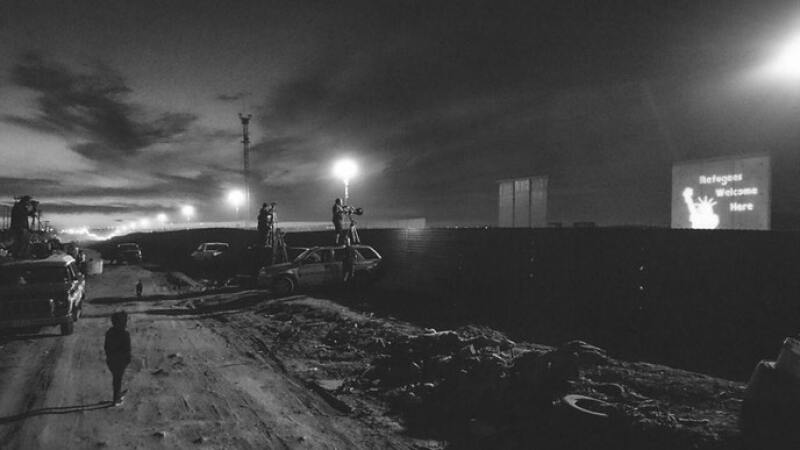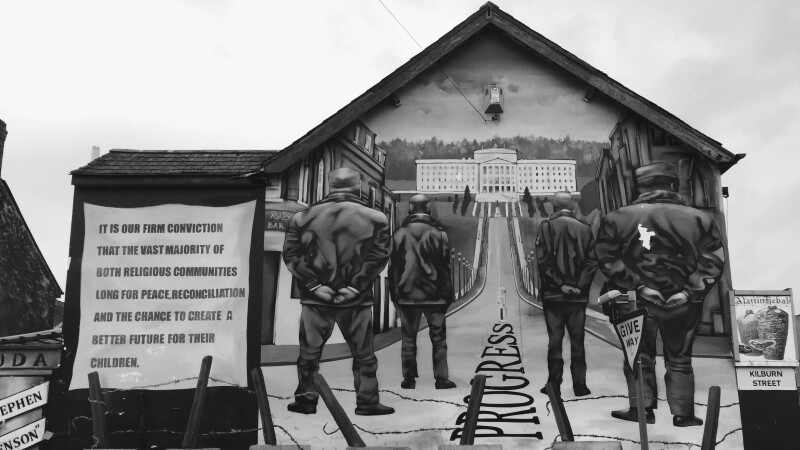Donald Trump wasn’t the first politician to dream of a “big, beautiful wall,” and he won’t be the last. Whether in Cold War–era Berlin or present-day West Bank, border walls have long been used to shut out people whose race, religion, economic status, or ideology have been deemed unwelcome by those in power or simply to “keep the peace.” But wherever anti-immigration politicians see opportunity, artists see canvas.
This week, two professors from California transformed a portion of the U.S.-Mexico border into a tool for human connection rather than separation. In a now-viral video posted to Instagram on Monday, July 29, children from both sides of the U.S.-Mexico border can be seen playing together on three bright-pink seesaws placed through the fence in Sunland Park, New Mexico (near El Paso, Texas), and Ciudad Juárez, Mexico.
The temporary art project, known as the “Teeter-Totter Wall,” was first dreamed up in 2009 by Ronald Rael, an architecture professor at the University of California, Berkeley, and San Jose State interior design associate professor Virginia San Fratello. After 10 years of conceptualizing, the installation came to life with Mexican soldiers and U.S. Border Patrol agents overseeing its construction at the highly politicized border. When the temporary seesaws were put in place, families on both sides of the wall gathered to play for approximately 30 minutes, capturing videos and photos that have since been widely shared across social media.
“The wall became a literal fulcrum for U.S.-Mexico relations,” Rael, who authored the 2017 book, Borderwall as Architecture: A Manifesto for the U.S.-Mexico Boundary, wrote in his original Instagram post about the project. “Children and adults were connected in meaningful ways on both sides with the recognition that the actions that take place on one side have a direct consequence on the other side.”
In addition to the more than 50,000 likes on Rael’s original post and reposts by users across Instagram, Facebook, and Twitter, the art project received praise from leading activism organizations, such as the Texas-based Refugee and Immigrant Center for Education and Legal Services (RAICES). On Twitter, RAICES representatives called the project “a beautiful installation at our southern border.”
The “Teeter-Totter Wall” is one of many instances where artists have co-opted border walls, which artificially stanch the free flow of people, ideas, and inspiration, and turned them into protest art about our collective humanity. Here are a few more notable examples.

With his community art project, “Mural de la Hermandad,” Enrique Chiu seeks to cover the entire U.S./Mexico border wall with murals.
Courtesy of Enrique Chiu
Dissolving Boundaries in Tijuana
The San Ysidro port of entry that connects Tijuana and San Diego is the busiest land border crossing in the world. Some 100 years ago, this boundary was marked by little more than flimsy cattle fencing. Today, the border wall’s rusting steel bars extend 300 feet into the Pacific Ocean. In 2011, Mexican artist Ana Teresa Fernandez “erased” the border by painting the fence to blend into the sea, sand, and sky (pictured at top). Just inland, Enrique Chiu is aiming to cover the length of the rest of the existing U.S./Mexico boundary wall with murals created by volunteers, artists, and community groups in border towns across the Southwest. Covering a distance of more than a mile and counting, Chiu’s Mural de la Hermandad (Brotherhood Mural) is gunning for the title of longest mural in the world.

The Walled Off Hotel’s Lobby looks directly onto the West Bank Barrier.
Photo by Yulia Denisyuk
Banksy at the West Bank Barrier
To mark the 100th anniversary of the British taking control of Palestine, the elusive London street artist Banksy opened The Walled Off Hotel in the West Bank, a quarter-mile from the Jerusalem checkpoint. In its name and with its dystopian decoration, the property makes an artistic statement about the isolation of the Palestinian territories. It’s also a fully functional hotel, complete with key fobs made to look like sections of the 400-mile separation wall and a gift shop selling mugs and T-shirts that say “The Worst View in the World.”

The 1990 mural “My God, Help Me to Survive This Deadly Love” was repainted by original artist Dmitri Vrubel in 2009.
Photo by Joachim F. Thurn/Wikimedia Commons
The East Side Gallery in Berlin
Erected in 1961, the Berlin Wall might be the most famous divider in recent history. It didn’t take long for its western face to be covered in graffiti protesting East German oppression. Although millions watched as it came down on live TV in 1989, a nearly mile-long stretch still runs through Berlin’s Friedrichshain-Kreuzberg neighborhood. Known as the East Side Gallery, the wall features more than 100 paintings celebrating reunification with messages of peace and freedom. Among the most iconic is My God, Help Me to Survive This Deadly Love (1990), a satirical reproduction of an actual photograph taken in 1979 when Leonid Brezhnev, then-leader of the Soviet Union, visited East Germany to celebrate the 30th anniversary of its founding as a communist state and greeted East German leader Erich Honecker with a fraternal kiss.

The Overpass Light Brigade projects messages of hope on the border wall prototypes in San Diego.
Photo by Jonathan Maier
Projecting Welcome in San Diego
As prototypes for Trump’s border wall were unveiled just north of the existing barrier near San Diego in November of 2017, artist-activists from the Overpass Light Brigade saw an opportunity. Known for shining protest messages made from strung LED lights over highways and in other public spaces after the sun goes down, the loose-knit group co-opted the massive slabs to project messages directed at would-be migrants from Mexico: One showed a ladder of light stretching to the top of the concrete panels; another read “Refugees Welcome Here” next to a silhouette of the Statue of Liberty.

BLU’s mural of the E.U. flag in Morocco
Courtesy of www.blublu.org
BLU’s E.U. Flag in Morocco
Refugees hoping to enter the European Union often try to scale the fence that separates Morocco from Melilla, a small North African territory claimed by Spain since 1497. In 2012, Italian street artist BLU painted this work, replacing the E.U. flag’s 12 yellow stars with sharp wire barbs that keep out a gathering crowd.

A massive photo of baby Kikito peers over the border fence in Tecate.
Courtesy of JR
JR’s Dreamers in Tecate
Located in Mexico but oriented toward viewers in the United States, French artist JR’s enlarged photograph of a one-year-old Dreamer peeking over the border fence elegantly captured what’s at stake in the debate over U.S. immigration policy: the lives and dreams of people brought to the United States as children (those protected under the DACA program are known as “Dreamers”). A month after the temporary installation, which went up in September of 2017, JR hosted the photo’s subject, Kikito, and the toddler’s family at a binational picnic nearby, with diners seated around a long table bisected by the border; aerial photographs of the meal reveal that the table was in fact a canvas, covered with a giant photograph of a pair of eyes that JR has confirmed belong to a Dreamer. By supersizing facial features to compete with the proportions of the border wall, JR elevates humanity above politics.

A somewhat rare conciliatory mural in Belfast
Photo by Chris Brooks/Flickr
The Troubles Murals in Northern Ireland
For three decades, 300 miles of “peace walls” separated warring Catholic and Protestant militias in Northern Ireland during the period known as “The Troubles.” The walls are slowly being dismantled, but sections remain; you can still see hundreds of political murals expressing support for Unionist (Protestant) or Nationalist (Catholic) causes on the remaining walls and on other buildings in cities like Belfast and Derry.

Street artist SYD’s Pink Floyd–inspired mural in Nicosia, Cyprus
Photo by SYD
SYD in the World’s Last Divided Capital
Greece and Turkey have been jostling for control of the tiny island of Cyprus since 1974. A U.N.-controlled demilitarized zone still runs through the city of Nicosia, making it the world’s last remaining divided capital. The Turkish and Greek sides are separated by cement walls, barbed wire, even blockades made from old barrels filled with dirt. In 2016, the situation prompted London street artist SYD to paint Break Down the Wall, inspired by Pink Floyd, on a section of freestanding wall.

Jarosław Koziara’s giant fish, created for the Land Art Festival
Courtesy of the Land Art Festival
Border-Crossing Crop Art in Poland and Ukraine
In 2011, Polish artists founded the annual Land Art Festival to promote cultural and scientific collaboration across international borders, specifically the border between Poland, which is part of the European Union’s Schengen area, and Ukraine, which is not. Cross-border designs like Jarosław Koziara’s giant fish, made from plants grown from seeds planted on both sides of the Poland-Ukraine border, quietly show how nature trumps geopolitical lines and remind us that borders don’t just separate, they also bind.
This article originally appeared online in February 2018; it was updated on July 30, 2019, to include current information.
>>Next: Can a Trip to the Holy Land Help a Republican and a Democrat Find Peace?











